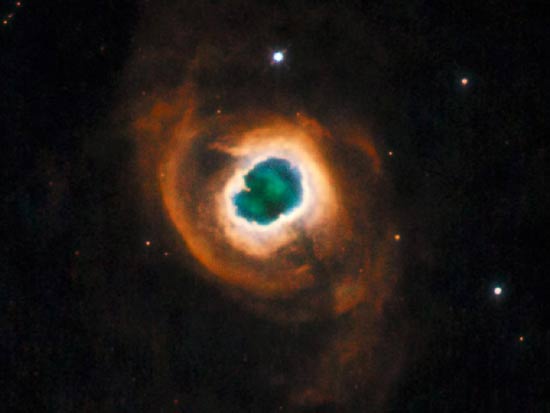Huge blue eyes in the universe
Hubble Space Telescope captures a stunning picture of an eye-like nebula on May 4.

Eye-shaped nebula in the universe.Such nebula-like nebulae are rare in the universe.Photo: NASA.
The aforementioned nebula is a colorful cloud of gas dust called Kohoutek 4-55, which has an "eye" facing the Hubble space telescope. The picture was taken with Hubble's No. 2 wide-angle camera. This is one of the last photos of this camera, because it is about to be replaced with the 3rd wide-angle camera in the next few days. NASA's Atlantis space shuttle leaves the launch pad yesterday to perform one of the most dangerous missions in orbit: Hubble telescope repair and maintenance.
Nebula is a mixture of dust, hydrogen gas, helium and plasma gas. They are often concentrated in narrow strips, ranging from a few tens to several hundred light years (1 light year = 9.460 billion km). The nebula has no relationship with the planet. They are called "nebulae" because when viewed with the first generation telescopes, they look like planets in the solar system. The galaxy has many nebulae. The "eye" in the picture consists of many physical layers of a red giant star. The star blows material layers into space before dying.
Ultraviolet radiation from the star's remaining hot core penetrates the outer layers of the gas, making them glow. The floor of the dust and gas glows brightly surrounded by a pale red halo. Each color is created by the radiation of a gas, such as nitrogen (red), hydrogen (green), oxygen (blue). Astronomers claim that nebulae with such multiple layers are relatively rare in the universe.
- People with blue eyes may have the same ancestors
- Turns brown eyes into blue eyes for 20 seconds
- Interesting things about the eyes
- Scientific research: People with brown eyes often lack luck
- Brown eyes are more reliable than blue-eyed ones?
- Huge blue eyes glow in the universe
- How far are our eyes?
- What is blue light? How is blue light harmful to the body?
- Mistakes people often have about blue light and effective eye protection
- Ghost images in the universe
- 19 most obsessive eyes in the history of world photography
- Why brown land?
 Van Allen's belt and evidence that the Apollo 11 mission to the Moon was myth
Van Allen's belt and evidence that the Apollo 11 mission to the Moon was myth The levels of civilization in the universe (Kardashev scale)
The levels of civilization in the universe (Kardashev scale) Today Mars, the sun and the Earth are aligned
Today Mars, the sun and the Earth are aligned The Amazon owner announced a secret plan to build a space base for thousands of people
The Amazon owner announced a secret plan to build a space base for thousands of people Never-before-seen image of the Crab Nebula revealed by the James Webb Telescope
Never-before-seen image of the Crab Nebula revealed by the James Webb Telescope  Top 6 mysterious objects that exist in the Solar System
Top 6 mysterious objects that exist in the Solar System  Photo of the 'flame nebula' more than 1,300 light-years away
Photo of the 'flame nebula' more than 1,300 light-years away  Hubble Telescope captures stunning image of star-forming Prawn Nebula
Hubble Telescope captures stunning image of star-forming Prawn Nebula  NASA captures 'future image' of Sun exploding and dying
NASA captures 'future image' of Sun exploding and dying  Christmas tree nebula in the constellation Unicorn
Christmas tree nebula in the constellation Unicorn 